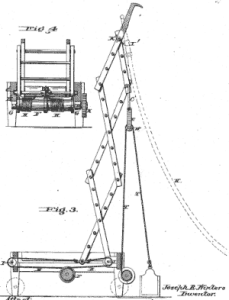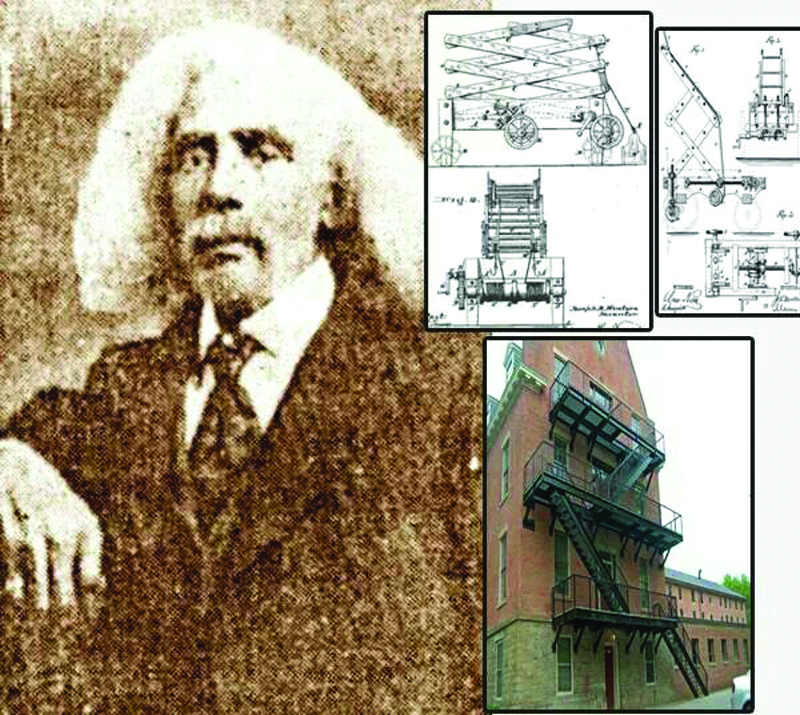The 19th century brought about changes in the architectural designs of many American cities. New materials were used, buildings began to reach skyscraper heights. The downside to these taller buildings was that, in case of fire, residents could not be evacuated as fast or as safe.
At that time, firefighters still used horse-drawn engines to carry their ladders. The length could not be excessive, as this would prevent the engines from turning corners if access to a narrow street or alley was necessary/
Joseph Winters (1816–1916) thought it would be more effective to mount the ladder on the engine itself, and that it could be fashioned in a way that it could be raised up in sections: foldable and collapsible. As a result, he invented a wagon-mounted fire escape ladder for the city of Chambersburg, Pa. His creation, which later received a patent (1878), would save countless lives within the inner city.
 Winters improved upon his design, receiving another patent in 1879. In 1882, he would patent the traditional fire escape: the model attached to the sides of buildings. Although he received much praise for creating lifesaving equipment, little money was made. Soon after, Winters took part in oil prospecting in the Chambersburg area. The venture proved unsuccessful.
Winters improved upon his design, receiving another patent in 1879. In 1882, he would patent the traditional fire escape: the model attached to the sides of buildings. Although he received much praise for creating lifesaving equipment, little money was made. Soon after, Winters took part in oil prospecting in the Chambersburg area. The venture proved unsuccessful.
He would later dabble in politics, writing a campaign song for Democrat William Jennings Bryan during the 1896 presidential campaign.
That Winters created the original design of the wagon-mounted ladder has been incorrectly reported. George Huttman and George Kornelio introduced the idea in 1849. Winters’ ladder was constructed of a metal frame and parallel steps; the original design was made of wood. It was 29 years after Huttman and Kornelio’s ladder that Winters’ own received a patent.
Winters was raised by his grandmother in Waterford, Va. during a time when many Black families were free, and Quakers were abolitionists. He worked as a farmer and later as a mechanic for the Cumberland Valley Railroad. He was also a fisherman and a hunter.
While working at Harpers Ferry sanding brick molds, Winters’ family decided to move to Chambersburg. There, he was active in the Underground Railroad, helping enslaved people escape to freedom. He wrote in his autobiography, “Ten Days After the Battle of Gettysburg,” that he arranged the meeting between Frederick Douglass and John Brown at the quarry in Chambersburg before the historic Harpers Ferry raid in 1859.
Douglass, however, wrote a different account of the events. His autobiography credits a local barber, Henry Watson. No copies of Winters’ autobiography have survived.
In 2005, a historic marker was placed at the Junior Hose and Truck Company #2 in Chambersburg. It notes Winters’ patents for the fire escape ladder and hose conductor as well as his involvement with the Underground Railroad.
Winters’ marital and parental status remain a mystery to researchers. He died sometime in 1916 near Chambersburg and is buried in the local Mount Lebanon Cemetery.

Tamara Shiloh
Tamara Shiloh has published the first two books in her historical fiction chapter book series,
Just Imagine…What If There Were No Black People in the World is about African American inventors, scientists and other notable Black people in history. The two books are
Jaxon’s Magical Adventure with Black Inventors and Scientists and
Jaxon and Kevin’s Black History Trip Downtown. Tamara Shiloh has also written a book a picture book for Scholastic,
Cameron Teaches Black History, that will be available in June, 2022.
Tamara Shiloh’s other writing experiences include: writing the Black History column for the Post Newspaper in the Bay area, Creator and Instruction of the black History Class for Educators a professional development class for teachers and her non-profit offers a free Black History literacy/STEM/Podcast class for kids 3d – 8th grade which also includes the Let’s Go Learn Reading and Essence and tutorial program. She is also the owner of the Multicultural Bookstore and Gifts, in Richmond, California,
Previously in her early life she was the /Editor-in-Chief of
Desert Diamonds Magazine, highlighting the accomplishments of minority women in Nevada; assisting with the creation, design and writing of a Los Angeles-based, herbal magazine entitled
Herbal Essence; editorial contribution to
Homes of Color; Editor-in-Chief of
Black Insight Magazine, the first digital, interactive magazine for African Americans; profile creations for sports figures on the now defunct PublicFigure.com; newsletters for various businesses and organizations; and her own Las Vegas community newsletter,
Tween Time News, a monthly publication highlighting music entertainment in the various venues of Las Vegas.
She is a member of:
- Society of Children’s Book Writers and Illustrators (SCBWI)
- Richmond Chamber of Commerce
- Point Richmond Business Association
- National Association of Professional Women (NAPW)
- Independent Book Publishers Association (IPBA)
- California Writers Club-Berkeley & Marin
- Richmond CA Kiwanis
- Richmond CA Rotary
- Bay Area Girls Club
Tamara Shiloh, a native of Northern California, has two adult children, one grandson and four great-grand sons. She resides in Point Richmond, CA with her husband, Ernest.
www.multiculturalbookstore.com


 Winters improved upon his design, receiving another patent in 1879. In 1882, he would patent the traditional fire escape: the model attached to the sides of buildings. Although he received much praise for creating lifesaving equipment, little money was made. Soon after, Winters took part in oil prospecting in the Chambersburg area. The venture proved unsuccessful.
Winters improved upon his design, receiving another patent in 1879. In 1882, he would patent the traditional fire escape: the model attached to the sides of buildings. Although he received much praise for creating lifesaving equipment, little money was made. Soon after, Winters took part in oil prospecting in the Chambersburg area. The venture proved unsuccessful.





































































1 Comment